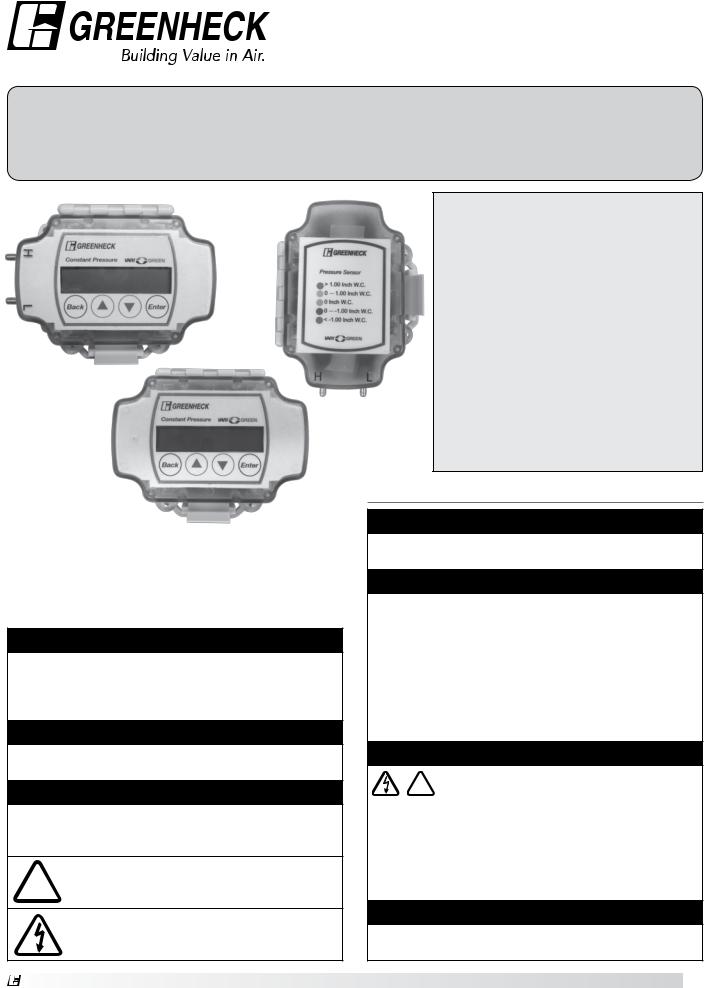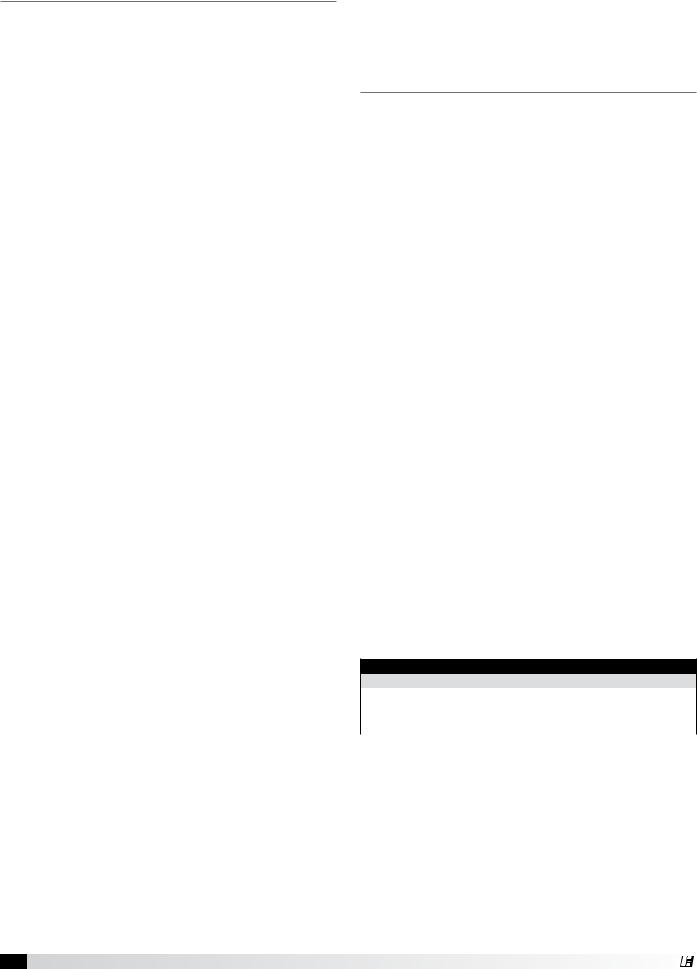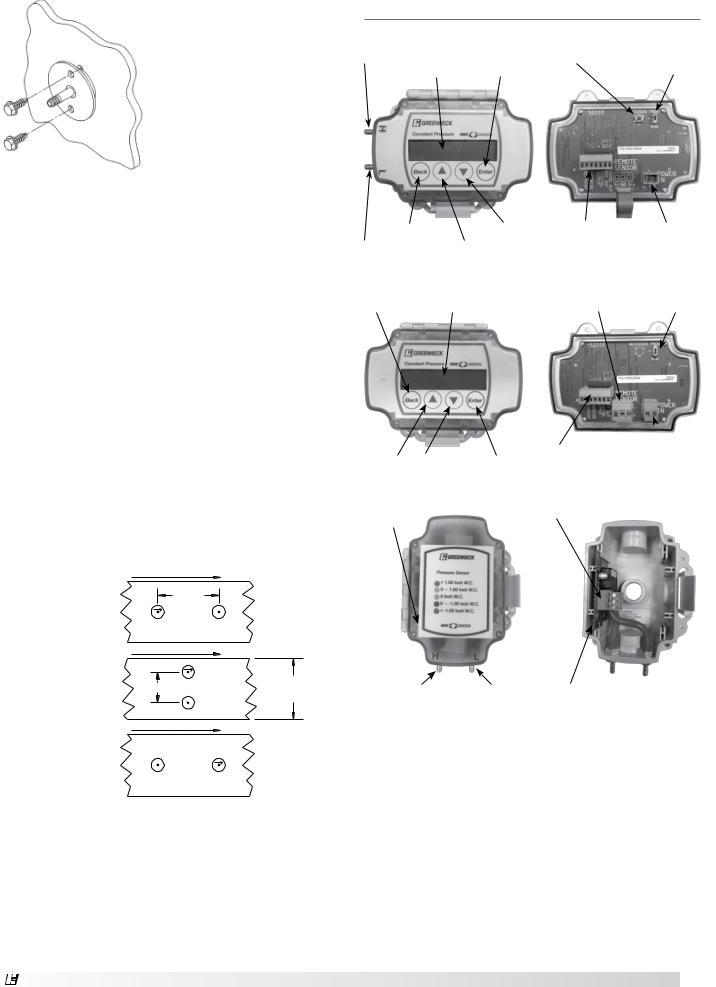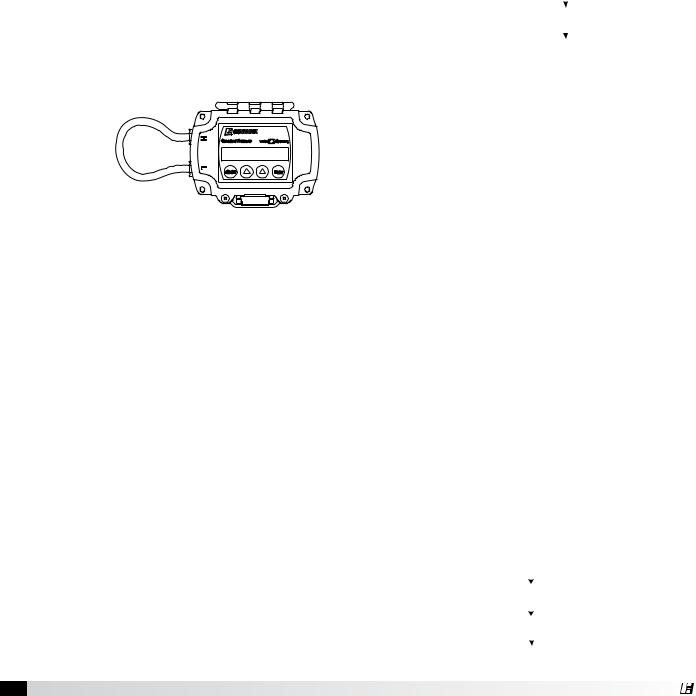Greenheck Vari-Green Control User Manual

|
Document 479653 |
|
Generation 2 |
® |
Constant Pressure/Air Flow Control |
Installation, Operation and Maintenance Manual
Please read and save these instructions for future reference. Read carefully before attempting to assemble, install, operate or maintain the product described. Protect yourself and others by observing all safety information. Failure to comply with instructions could result in personal injury and/or property damage!
Remote
Transducer
Controller with
Integral Transducer
Controller with
Remote Transducer
Precautions and Warnings
To prevent injury and property damage, follow these instructions. Failure to adhere to installation/operation procedures and all applicable codes may result in hazards as indicated by warning codes outlined below:
DANGER
Indicates an imminently hazardous situation which, if not avoided, will result in death or serious injury. This signal word is to limited to the most extreme situations.
WARNING
Indicates a potentially hazardous situation which, if not avoided, could result in death or serious injury.
CAUTION
Indicates a potentially hazardous situation which, if not avoided, may result in minor or moderate injury. It may also be used to alert against unsafe practices.
This is the safety alert symbol. Read and follow instructions carefully to avoid a dangerous situation.
This symbol alerts the user to the presence of “dangerous voltage” inside the product that might cause harm or electrical shock.
Table of Contents |
|
Constant Pressure Control ................... |
2 |
Installation ............................................ |
2 |
General Operation ........................... |
3 - 5 |
Initial Setup Menu Structure ................ |
6 |
Setpoint Edit Menu Parameters ........... |
7 |
Initial Setup Menu Parameters ............. |
8 |
Wiring Diagrams Overview .............. |
9-10 |
Part Number Table ............................. |
10 |
Air Density Correction Factors ........... |
11 |
Specifications ..................................... |
11 |
Assembly Part Numbers .................... |
11 |
Mounting Hole Pattern ....................... |
11 |
Safety Instructions |
|
DANGER |
|
Equipment can start automatically. Lockout/tagout before servicing.
CAUTION
As with all electrical products, read manual thoroughly. Only qualified, expert personnel should perform maintenance and installation. Contact the nearest authorized service facility for examination, repair, or adjustment. Do not disassemble or repair unit unless described in this manual; death or injury to electrical shock or fire hazard may result. Specifications and manual data subject to change. Consult factory for additional information.
DANGER
HAZARDOUS VOLTAGE
•Disconnect and lock out all power before installing or servicing equipment.
•This equipment may require locking out multiple power sources prior to service.
•Install and wire in accordance with all applicable local and national electrical and construction codes.
WARNING
FAILURE TO FOLLOW THESE INSTRUCTIONS MAY RESULT IN DEATH OR SERIOUS INJURY.
Constant Pressure Control |
1 |

Constant Pressure Control
The Greenheck Constant Pressure Control is designed to maintain a constant level of static pressure or airflow by automatically adjusting the speed of a fan or position of damper. The Constant Pressure Control output is compatible with the Vari-Green® Motor, many variable frequency drives (VFDs), or dampers with modulating actuators.
The Constant Pressure Control is available with duct or room mounted probes for static pressure control, as well as a pitot tube or Greenheck’s AMS (Airflow Monitoring Station) for maintaining airflow. Common applications include:
•Multi-story
•Variable volume exhaust systems serving bathrooms
•Residential kitchen hoods or clothes dryers
•Room pressurization and filtered supply/exhaust where constant airflow is required as the filters become dirty
Receiving
Upon receiving the control, check to ensure all items are accounted for by referencing the delivery receipt or packing list. Inspect each crate or carton for shipping damage before accepting delivery. Alert the carrier
of any damage detected. The customer will make notification of damage (or shortage of items) on the delivery receipt and all copies of the bill of lading which is countersigned by the delivering carrier. If damaged, immediately contact your Greenheck Representative. Any physical damage to the unit after acceptance is not the responsibility of Greenheck Fan Corporation.
Unpacking
Verify that all required parts and the correct quantity of each item have been received. If any items are missing, report shortages to your local representative to arrange for obtaining missing parts.
Storage
Controls are protected against damage during shipment. If the control cannot be installed and operated immediately, precautions need to be taken to prevent deterioration of the control during storage. The user assumes responsibility of the control and any accessories while in storage. The manufacturer will not be responsible for damage during storage. These
suggestions are provided solely as a convenience to the user.
Indoor - The ideal environment for the storage of control is indoors, above grade, in a low humidity atmosphere which is sealed to prevent the entry of blowing dust, rain or snow. Temperatures should be evenly maintained between 30° to 110°F (-1° to 43°C). Wide temperature swings may cause condensation and “sweating” of metal parts. All accessories must be stored indoors in a clean, dry atmosphere.
2 Constant Pressure Control
Removing from Storage
As controls are removed from storage to be installed in their final location, they should be protected and
maintained in a similar fashion until the control goes into operation.
Installation
Parts Needed
•Control voltage wiring – 18-20ga recommended
•Pressure tubing – 1/4 inch (6mm)
•Fasteners for mounting
•Conduit fittings (1/2 inch (13mm) NPSM)
Note: Mounting hole pattern for controller and transducer on pg. 11.
Controller – Integral Pressure Transducer
The controller with integral pressure transducer is a NEMA-4 rated enclosure. Mount the controller in a location where it can be accessed for programming and status viewing. The controller should be mounted in an environment where the temperature remains between 45° and 80° F. (7° and 27°C). This temperature range
is due to the temperature compensation range of the integral pressure transducer. If the controller needs to be mounted in a location that will routinely exceed this range, the controller that accepts a remote transducer should be used.
The controller should be mounted with the hinge of the door on top. Keep in mind wiring and tubing lengths when selecting a location.
Controller – Remote Pressure Transducer
The controller with remote pressure transducer is used for applications where the controller must be mounted in areas where the temperature may exceed the compensation range of the pressure transducer.
Both the controller and remote pressure transducer are in a NEMA-4 rated enclosure. The pressure transducer should be mounted in an environment where the temperature remains between 45° and 80°F
(7° and 27°C)
Maximum Recommended Distances
|
Tubing |
Wiring |
Probe to Transducer |
100 feet (30.5m) |
N/A |
Transducer to Controller |
N/A |
200 feet (61m) |
Controller to Fan/Motor/VFD |
N/A |
100 feet (30.5m) |
Conduit Fittings
Connections - A stepped drill bit can be used to create openings in the conduit fittings. Take care to not damage the components inside the housing
when drilling.
Pressure Probes
A duct static, room static, 2-piece pitot tube and AMS are available from Greenheck. Other pressure probes may be used as well.
Duct Static Probe (FIG. 1)
The duct static probe must be located in the duct where

FIG. 1 |
you intend to control the static |
|
pressure. It should be located |
||
|
||
|
a minimum of 10’ away from |
|
|
the inlet/outlet of the fan/ |
|
|
damper to ensure stable |
|
|
operation. |
The duct static probe is always connected to the “H” port
of the control/transducer. The “L” port is the reference port and can remain open to
atmosphere or plumbed to another location.
Room Static Probe
The room static probe is used to sample the pressure in an open space such as a room or hallway. The pressure controlled room must be connected to the “H” port. The “L” port is the reference port and can remain open to atmosphere or plumbed to another location.
Alternatively, if the controller/transducer is mounted in the space in which the pressure is to be controlled,
the “H” port can remain open and the “L” port must be plumbed to another location for reference.
2-Piece Pitot Tube
The 2-piece pitot tube consists of a total pressure (PT) probe and a static pressure (PS) probe. These probes should be mounted in a straight section of ductwork located away from elbows or transitions. The total pressure probe can be identified by a 45deg. cut at the end and the arrow identifying airflow direction on the mounting flange.
Examples for mounting the probes are shown in FIG. 2 (A, B, C).
AIR FLOW
|
FIG. 2 |
|
4-8 in. |
|
|
|
|
|
|
||
|
|
|
(102-203mm) |
|
|
(A) |
CORRECT |
PT |
PS |
|
|
|
|
|
|||
|
|
AIR FLOW |
|
|
|
|
|
|
PT |
12 in. (305mm) |
|
(B) |
CORRECT |
2-4 in. (51-102mm) |
|||
OR GREATER |
|||||
|
|
|
PS |
||
|
|
|
|
||
AIR FLOW
(C) INCORRECT
PS PT
Connect the total pressure probe to the “H” port of the control/transducer and the static pressure probe to the “L” port.
AMS (Airflow Measuring Station)
The AMS should be mounted away from elbows and transitions. Connect the “HIGH” port of the AMS to the “H” port and the “LOW” port of the AMS to the “L” port of the control/transducer.
General Operation
Controller with Integral Transducer
H Pressure Port |
|
Auto Zero Button |
Display |
Enter Button |
PROG/RUN Switch |
Back Button |
Down Arrow |
Control Wiring |
Power Wiring |
L Pressure Port |
Up Arrow |
Connector |
Connector |
|
|
||
|
|
||
Controller with Remote Transducer |
|
||
Back Button |
Display |
Romote Transducer |
PROG/RUN |
Wiring Connector |
Switch |
||
Up Arrow Down Arrow Enter Button |
Control Wiring |
Power Wiring |
Connector |
Connector |
|
|
|
|
Remote Transducer |
|
|
Pressure |
Wiring Connector |
|
Status LED |
|
|
H Pressure Port |
L Pressue Port |
Auto Zero Button |
Display
The 2-line multi character display is backlit and is used to read the status of the control as well as setting parameters during programming.
Touch Buttons
The buttons on the front of the control are touch sensitive, similar to the touch screen of a smartphone. Gloves must be removed to ensure it senses your finger. In RUN mode, the arrow buttons can be used to display different process variables. In PROG mode, the arrow, enter and back buttons are used to navigate the menus and set parameters. When using the arrows to set parameters, holding the button down will increase the scrolling speed.
Constant Pressure Control |
3 |

LED Status
A status LED exists on the control and remote pressure transducer.
Control:
Green = Normal Operation
Pink = Programming/manual mode Flashing Yellow = Cutout timer is active Solid Yellow = Cutout mode is active Red = Override active
Transducer:
Red = >1.00 in.WC (>249Pa) Green = 0 —1.00 in.WC (0-249Pa) Yellow = 0 in.WC (0Pa)
Blue |
= 0 — -1.0 in.WC (249Pa) |
Pink |
= < -1.00 in.WC (249Pa) |
Pressure Transducer Auto Zero
The integral and remote pressure transducer includes an auto zero function. There is an auto zero button on the inside of the enclosure. If the controller is already installed, remove field tubing and connect the “H” and “L” port of the pressure transducer together with a short piece of tubing (Fig. 3). Press the auto zero button inside the
enclosure. When
the LED stops flashing, remove the tubing and reconnect the
existing field tubing.
Inputs/Outputs
The controller contains the following inputs/outputs:
Inputs:
Remote Override (digital, dry contact)
•Activating this input will force the Fan Speed output to a fixed % (adjustable)
Remote Setpoint (analog, 0-10V or 2-10V)
•A voltage signal can be sent to the control to remotely adjust the setpoint.
Remote Transducer (analog, 0-10V)
•Not available on controller with integral transducer.
Outputs:
Fan Speed (analog, 0-10V, 2-10V)
Pressure/Airflow Reference (analog, 0-10V)
•The output will send the actual pressure/airflow value to another device, such as BMS.
Relay (digital, 0.5A rating)
•The relay output will close when the Fan Speed output is above a set % (adjustable). Common uses are to signal a dirty filter in airflow mode or signal another device that the fan is being called to run.
4 Constant Pressure Control
RUN/PROG Mode
Run and Program mode are set using the selector switch on the inside of the control. Open the control enclosure to access the switch.
RUN Mode
This control has two major functions – constant pressure mode and constant airflow mode.
(Set using initial set up menu. pg. 6 & 7)
Constant Pressure Mode - the control will automatically adjust the speed of the fan to maintain a constant static pressure in a duct or room.
The display will show the following variables (touch the arrow buttons to change the display):
Static Pressure Reading |
|
|
|
Ps: -X.XX in WC |
|
||
Output % |
Output: XX.X% |
|
|
|
|
|
|
|
|
|
|
Pressure Setpoint |
Ps: -X.XX in WC |
|
|
Set: -0.10 in WC |
|
||
|
|
|
|
|
|
|
|
Cutout Threshold % |
Ps: -X.XX in WC |
|
|
|
Cutout: 20.0% |
|
|
|
|
|
|
Cutout – The following definitions will be used to provide clarity in the explanation of the cutout feature.
Primary Fan:
The controller is connect to this fan. Secondary Fan:
Any fan, other than the primary fan, that influences the pressure in the system
The cutout feature is available to turn the primary fan off in times of no demand from the secondary fans.
There are three parameters related to the cutout function: Cutout %, Cutout Delay Time and Return from Cutout Pressure Setpoint.
Cutout mode is activated when the fan speed
output % is less than the cutout % setpoint. After the Cutout Delay Time has elapsed, the control will turn the output OFF.
A change in system pressure is needed to turn the output back ON. This value is adjustable to prevent false pressure fluctuations from turning the fan back on.
Constant Airflow Mode – the control will automatically adjust the speed of a fan to maintain a constant airflow rate in a duct.
The display will show the following variables(touch the arrow buttons to change the display):
Airflow Reading |
|
|
|
|
Flow: XXXXX CFM |
|
|||
Output % |
Output: XX.X% |
|
||
Differential Pressure |
|
|
|
|
|
Flow: XXXXXX CFM |
|
||
Reading |
|
Dp: X.XX in WC |
|
|
|
|
|
|
|
|
|
|
|
|
Velocity Reading |
Flow: XXXXXX CFM |
|
||
|
|
Vel: XXXXX FPM |
|
|
Airflow Setpoint |
|
|
|
|
Set: XXXXX CFM |
|
|||
|
|
Flow: XXXXX CFM |
|
|
|
|
|
|
|
